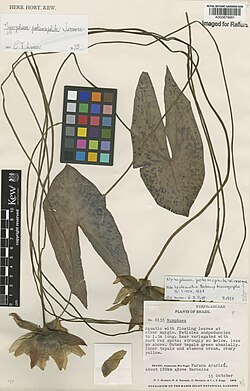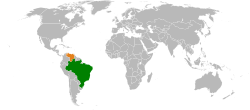Biology:Nymphaea potamophila
| Nymphaea potamophila | |
|---|---|

| |
| Preserved herbarium specimen of Nymphaea potamophila Wiersema in the collection of the Royal Botanic Gardens, Kew | |
| Scientific classification | |
| Kingdom: | Plantae |
| Clade: | Tracheophytes |
| Clade: | Angiosperms |
| Order: | Nymphaeales |
| Family: | Nymphaeaceae |
| Genus: | Nymphaea |
| Species: | N. potamophila
|
| Binomial name | |
| Nymphaea potamophila Wiersema[1]
| |

| |
| It is native to Venezuela and northern Brazil[1] | |
Nymphaea potamophila is a species of waterlily native to the region spanning from Venezuela to northern Brazil.[1] Additionally, it has been reported to occur in Colombia.[2][3]
Description
Vegetative characteristics
Nymphaea potamophila is an aquatic herb. The elliptic-sagittate, papery leaf blades of floating leaves are up to 20 cm long and 10 cm wide.[4] The leaf margin is entire and flat.[5] The adaxial surface is coloured in green with overlaying patterns of red variegation. The abaxial surface has a greenish base colour accompanied by dark red variegation, but also exhibits patterns of branched, rusty-brown striations.[4] The leaf structure is compact and the leaves are very thin (145.50 μm). This gives the leaves cold tolerance.[6] The glabrous, 3 mm wide petioles are very long and can exceed 4 m in length.[4]
Generative characteristics
The nocturnal floating flowers are connected to glabrous, 4 mm wide peduncles, which can exceed 4 m in length.[4][7]
Cytology
The chloroplast genome size is 159,232 bp.[8] The chromosome count is unknown.[7]
Reproduction
Vegetative reproduction
Proliferating pseudanthia are not formed in this species.[5][7]
Generative reproduction
High levels of both pollen viability and seed production are evident in Nymphaea potamophila. Sexual reproduction plays a significant role in this species.[4][7]
Habitat
It can be found in the aquatic habitats of the Amazon Rainforest,[5] where it can grow along river margins in up to 4-5 m deep water.[7][4]
Taxonomy
Type specimen
The type specimen was collected in Brazil by a team of scientists consisting of J. Ramos, C.D. Mota, L.A. Maia, and E. Soares on the 28th of June 1979.[4][9]
Placement within Nymphaea
It is placed in Nymphaea subgenus Hydrocallis.[8][4]
Conservation
The conservation status of this species in Brazil has not yet been evaluated.[5]
References
- ↑ 1.0 1.1 1.2 "Nymphaea potamophila Wiersema" (in en). Royal Botanic Gardens, Kew. http://www.plantsoftheworldonline.org/taxon/281440-2. Retrieved 8 November 2023.
- ↑ Atuesta-Ibargüen, D. J. (2019). Composición florística y formas de vida de las macrófitas acuáticas de la serranía de La Lindosa (Guaviare), Guayana colombiana - Floristic composition and life forms of aquatic macrophytes of serrania La Lindosa (Guaviare), Colombian Guiana. Caldasia, 41(2), 301–312. https://www.jstor.org/stable/26680473
- ↑ GBIF, Global Biodiversity Information Facility. (n.d.). Nymphaea potamophila Wiersema. Retrieved November 8, 2023, from https://www.gbif.org/species/3697289
- ↑ 4.0 4.1 4.2 4.3 4.4 4.5 4.6 4.7 Wiersema, J. H. (1984). "A new species of Nymphaea (Nymphaeaceae) from the Amazon Basin." SIDA, Contributions to Botany, 195-198.
- ↑ 5.0 5.1 5.2 5.3 Jardim Botânico do Rio de Janeiro. (n.d.). Nymphaea potamophila Wiersema. Flora E Funga Do Brasil. Retrieved November 8, 2023, from https://floradobrasil.jbrj.gov.br/consulta/ficha.html?idDadosListaBrasil=86095
- ↑ Yang, K. (2022). "Leaf Anatomic Structure and Cold Tolerance Evaluation of 6 Nymphaea Species." Plant Gene and Trait, 13.
- ↑ 7.0 7.1 7.2 7.3 7.4 Wiersema, J. H. (1987). A monograph of Nymphaea subgenus Hydrocallis (Nymphaeaceae). Systematic Botany Monographs, 1-112.
- ↑ 8.0 8.1 Sun, C., Chen, F., Teng, N., Xu, Y., & Dai, Z. (2021). "Comparative analysis of the complete chloroplast genome of seven Nymphaea species." Aquatic Botany, 170, 103353.
- ↑ Nymphaea potamophila | International Plant Names Index. (n.d.). Retrieved November 9, 2023, from https://www.ipni.org/n/281440-2
Wikidata ☰ Q15481725 entry
 |

